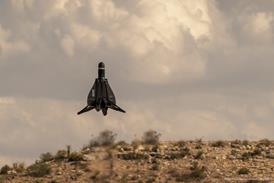Based on nearly 20h of flight testing and hundreds of windtunnel runs, Piper Aircraft is homing in on the final aerodynamic design of its new $2.2 million single-engined PiperJet, scheduled for first deliveries in the fourth quarter of 2011.
Performance metrics revealed during 13 test flights totalling 18.7h between the first flight on 30 July and 27 August include a full-flap (36°) stall speed of 65kt (120km/h), 3,400ft/min (17.3m/s) maximum rate of climb with gear down and the ability to take off in 640m (2,100ft) and land in 730m, both over a 50ft obstacle.
Largely a clean-sheet design, the six- to seven-seat PiperJet is the first example of a new Piper philosophy brought in by James Bass, chief executive since 2004. "Anything we build will be optionable," says Bass. By optionable, Bass means for example that the laminar flow wing of the PiperJet can be transferred "up and down the product line", which includes the cabin-class piston-powered single Matrix and Mirage, as well as the Meridian turboprop. Similarly, the PiperJet's cabin was derived from the Meridian frame with a 122cm (48in) spacer.
 |
|---|
© John Croft/Flight International |
Bass says Piper will attempt to "dominate" the $600,000-2.5 million product range, although support will continue for its lower-end training aircraft such as the Warrior III. New designs, including the PiperJet, will also include a 1.3 "banding tolerance", Bass says, meaning that the aircraft or its major components by design will be capable of being scaled up or down by a factor of 1.3. In the case of the PiperJet, the philosophy, evident in the down-rating of the Williams International FJ44-3AP from 3,000lb thrust (13kN) to 2,490lb, roughly a factor of 1.3, could be an indication that a larger version of the aircraft is planned.
Along with optionable components, the PiperJet also features new aluminium bonding techniques that allow for a "glass-smooth" finish that is key to the aircraft attaining laminar flow across the front 80% of its wing chord. Engineers also placed the forward and aft wing spar carry-through structure under the cabin floor, easing entry and exit from the cockpit, and added winglets primarily to increase aileron effectiveness and authority, says Bob Kromer, vice-president of sales, marketing and aftermarket support for Piper.
The 13.5m wing has a 4.5° dihedral and an aspect ratio of 9.73. Piper estimates the wing will yield a 17:1 glide ratio, a 70% increase over the Meridian's glide ratio, providing a 210km (113nm) glide distance from its maximum operating altitude of 35,000ft. Fowler wing flaps deploy aft by 38.1cm and rotate down to 36° for landing, decreasing the stalling speed from 88kt to 65kt. The PiperJet's ailerons are controlled by traditional direct linkage push-pull tubes and rotate 25° up and 15° down.
The aircraft's tailplane features a vertical stabiliser that tops out at 4.82m, with redundant control cables that wrap around the amour plating on the turbofan engine, put in place for turbine burst protection. Windtunnel tests at the University of Washington revealed the need for a fillet above the engine to reduce drag, and the need to move the engine higher to prevent ingestion of ice shedding from the top of the fuselage, says Kromer.
Ice protection includes pneumatic boots on the wings and tail surfaces, electric windshield heat and engine bypass heat for the engine inlet. One downside of the high engine is that pilots are likely to need a telescoping wand to test-spin the fan blades during pre-flight, although oil quantity and chip detection will be possible through indicators in the cockpit.
Although the current design includes hooks for an automatic horizontal stabiliser trim system to help pilots control the nose-down moment caused by the position of the engine during go-around manoeuvres, Kromer says a new tailpipe canted up 6° has helped produce much more benign pitch changes in the actual aircraft than had been expected from windtunnel tests. As such, Piper may decide to fix the horizontal stabiliser in place and remove the automatic trim system, leaving the left and right elevators for pitch control. For stability reasons, the horizontal stabiliser of the close-coupled airframe is swept back 27.5°, resulting in an increase moment arm for the tail. Engineers expect a centre of gravity range of roughly 255mm.
Future design work will see drag devices, most likely spoilers, included on the wings to allow for airliner-compatible 250kt high-speed descents from cruise altitudes. Piper also plans to include a trailing link landing gear on the single-tyre main landing gear, which will include anti-skid brakes, says Kromer.
Source: Flight International























